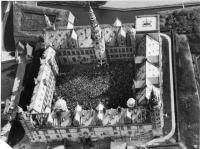Now that evidence of change on a national scale had emerged in Norway and Denmark, Buchman wished to bring it to bear on the Continent, and especially upon Germany. He conceived a great Scandinavian demonstration, which took place on Whit Sunday at Kronborg (popularly known as 'Hamlet's Castle') at Elsinore. The castle courtyard was tilled with ten thousand people, and other thousands listened through loudspeakers on the grassy ramparts outside. Late that night Clemmensen wrote of the endless streams of people, the rise and fall of the music, the people from politics and the Church on the platform and the youth, the farmers, and the workers who spoke of listening to the voice of the Living God and obeying. He sketched Buchman's life, and went on, 'I have never heard of anything like it in our age. This man had the determined vision of the conquest of the world. He came as an unknown soldier from one of Christendom's front-line trenches, and stood today in this Danish Castle as the leader of a modern crusade that spans the world.'47
Soon after this demonstration Buchman returned to Britain for an Oxford house-party, which was attended by hundreds from Scandinavia. In September he returned to the Danish province of Jutland with a team of nearly 1,000, which, according to Emil Blytgen-Petersen, 'swept over the peninsula like a sandstorm’48 and visited practically every town and village.

Alfred Nielsen, manager of a sawmill in North Schleswig, just short of the German border, was living in constant fear of what the slump might do to his business and industry. 'I followed Buchman round Jutland like a dog, because I wanted the answer I saw in him,' he says. 'What he gave me saved me from a mental breakdown. He opened my eyes to my selfish pride towards my wife, my workers and my colleagues - and towards the Germans living with us in North Schleswig.'49 One result, according to Scandinavian Review, was that Nielsen, 'proprietor of the largest sawmill combine in Jutland', who had earlier ‘refused to grant his employees a wage increase ... on the plea that his firm’s finances would not stand it, honestly told his men in 1937 that the true reason was that his private pocket would have suffered. He went into the entire finances of the firm with his men and they agreed unitedly upon adequate provision for everyone.'50
By late 1935 the Oxford Group in Denmark was working under Danish leaders. On 18 October 1935, less than seven months after Buchman's arrival in Copenhagen, 25,000 assembled in the Forum there and in two overflow halls. Paul Brodersen, Dean of Copenhagen, led the demonstration and the speakers included a carpenter, a nurse, a horse-dealer from an outlying island, the head of an oil refinery and two of his employees, Copenhagen's top band leader, the Director of the National Technological Institute and fifteen students led by the President of the Copenhagen University Student Council. The audience, wrote Berlingske Tidende, 'was not of any one class or type or age, but the whole electoral roll from A to Z'.51
230
Photo: 10,000 people in the courtyard of Kronborg Castle at Elsinore, Denmark.
©Nordisk Pressphoto